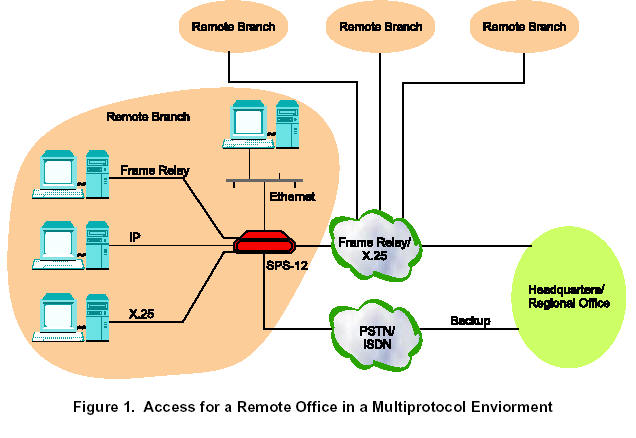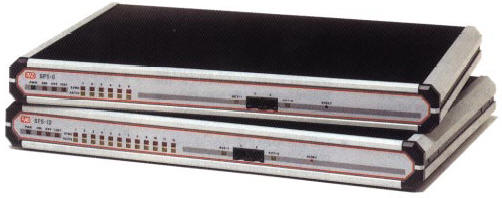|
FEATURES
- SPS-6 and SPS-12 are multiprotocol packet switches
with six or twelve ports respectively. They are intended for the remote
branch office. Every three ports support aggregated data rate of up to 2
Mbps.
- A typical applications shows access for the remote
office in a multi-protocol environment (see Figure 1)
FRAME RELAY
- SPS-6 and SPS-12 provide access and switching to
public or private Frame Relay networks.
- SPS-6 and SPS-12 consolidate Async, HDLC, IP and
X.25 over the Frame Relay cloud.
- As a Frame Relay switch, the units can integrate
DLCIs from several sources into a single port. SPS-6, SPS-12 can also
support BECN/FECN signaling for congestion avoidance.
- A unique funneling mechanism adjusts feeder
throughput to CIR levels.
- For each DLCI, an optional backup Frame Relay link
is available.
- The Frame Relay multicasting feature (complies with
FRF-7), enables multicasting frames from one DLCI onto several DLCIs. The
feature supports one-way, two-way and broadcast communication options.
- LMI and ANSI PVC management protocols are supported
in compliance with ANSI T1.606, T1.618, T1.617 Annex D, and ITU Rec.
Q.922, Annex A.
- SPS-6 and SPS-12 support CLLM management protocol
and complies with ITU REC Q.933, Annex A.
X.25
- X.25-configured links support permanent virtual
circuits (PVCs) and switched virtual circuits (SVCs). Link packet size is
up to 4096 bytes.
- SPS-6 and SPS-12 support both mandatory and
additional ITU X.25 facilities.
- Dial-up X.25 links are supported via a dial-up
modem controlled by a DTR signal or V.25 bis commands.
- SPS-6 and SPS-12 support X.25 multicasting.
X.32
- SPS-6 and SPS-12 support X.32 protocol for a
dial-up X.25 link. This enables users to access an X.25 network remotely
via a dial-up modem with X.32, or to use the backup dial-up link for an
X.25 or Frame Relay network.
HDLC TRANSPARENT ACCESS
- Each port can be programmed to operate in
transparent HDLC mode for connecting bridges, routers and other HDLC
communication devices over X.25 or Frame Relay networks. The HDLC protocol
is encapsulated over X.25 or Frame Relay, providing end-to-end transparent
operation.
ASYNC ACCESS
- All async channels can act according to X.3, X.28
and X.29 profiles at traffic speeds of up to 115.2 kbps. Async traffic can
be packetized directly over the Frame Relay network, or packetized over
the X.25 network. All channels are configured and monitored by the
management agent of SPS-6 and SPS-12.
- Each one of the SPS-6 and SPS-12 ports can be
configured to SLIP or PPP modes, operating at data rates of up to 115.2
kbps.
- IP PAD facilities allow easy migration of terminal
/ server applications to an IP environment, at the same time improving its
durability.
IP ROUTING
- IP datagrams can be routed over Ethernet, PPP or
SLIP links and over Frame Relay networks (according to RFC 1490) or over
an X.25 network (according to RFC 1356).
- SPS-6 and SPS-12 support RIP1, RIP2 and triggered
acknowledgment RIP messages (according to
RFC 1058, 1723 and 1724). The RIP support enables easy IP connection while
minimizing IP user configuration. The triggered RIP enables reduction of
the overhead associated with the RIP mechanism, by minimizing the number
of periodic messages sent.
- Static IP routing is supported. IP packets are
routed to destination via SLIP, PPP, LAN (Ethernet), X.25 or Frame Relay
link, according to the IP address.
ETHERNET
- The Ethernet interface enables bridging and/or
routing of LAN packets over a Frame Relay network (according to RFC 1490)
and over an X.25 network (according to RFC 1356).
ISDN
- PPP/FR/X.25 can be transmitted over the ISDN media.
- ISDN support includes up to 128 kbps (Bundle two B
channels).
NETWORK MANAGEMENT
- SPS-6 and SPS-12 contain an SNMP agent, which
enables remote configuration, collection of statistics / status reports,
and diagnostics. The management agent can be programmed to periodically
send statistics and status reports to a maximum of five management
stations.
- Configuration, monitoring and controlling of all
network resources can be performed from a RADview-PC or RADview-HPOV/UNIX
SNMP management station.
- A management station can be connected directly to
SPS-6 and SPS-12 using LAN, PPP or SLIP.
- SPS-6 and SPS-12 SNMP agents support private and
standard MIBs, including MIB II with RFC 1213, RFC 1381 and RFC 1382 for
X.25, and RFC 1315 for Frame Relay.
BACKUP
- Enhanced backup facilities include PSTN/ISDN
support.
- Frame Relay, X.25 and PPP can be transmitted over
the ISDN media.
- SPS-6, SPS-12 feature an automatic return to main
link facility after a network recovery.
SPECIFICATIONS
- FRAD/PAD and multiprotocol packet switch
- Protocols supported: Frame Relay, X.25, IP, HDLC,
SLIP, PPP, ML-PPP and Async
- IP support:
- RIP1, RIP2 and static routing
- Standard IP encapsulation over Frame Relay (RFC
1490), or X.25 (RFC 1356) networks
- Standard bridging
- Telnet client / server to support terminal / server
applications
- SNMP management using RADview PC / UNIX platforms
- Optional built-in Ethernet, allowing easy
integration of LAN segments
- Optional support for ISDN: Frame Relay / X.25 / PPP
/ ML-PPP can be transmitted over the ISDN media
- FLASH memory for software upgrade
SPS-6/*/$
6-port Multiprotocol FRAD/Switch
SPS-12/*/$
12-port Multiprotocol FRAD/Switch
| * |
Specify optional DC power supply:
24 for 24 VDC
48 for 48 VDC
|
| $ |
Specify special interfaces:
UTP for 10BaseT Ethernet interface
BNC for 10Base2 interface
IBE for ISDN BRI `S' interface
IBU for ISDN BRI `U' interface
DDS for integral DDS interface
(default is without special interfaces)
|
SPS-M/#
| # |
Specify interface:
V24 for V.24/RS-232 interface
V35 for V.35 interface
V36 for V.36/RS-449 interface
X21 for X.21 interface
530 for RS-530 interface
|
Note: All V.35, X.21 and V.36 interfaces
include an adapter cable.
ORDERING
SPS-6
SPS-6/DDS
SPS-6/IBU/SNA
SPS-6/SNA
SPS-6/UTP
SPS-6/UTP/SNA
APPLICATIONS

|

